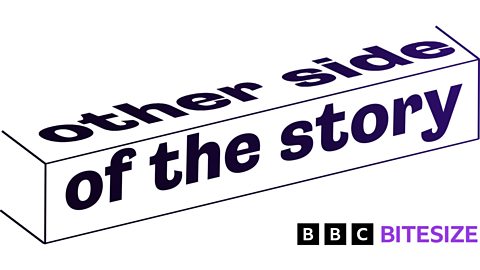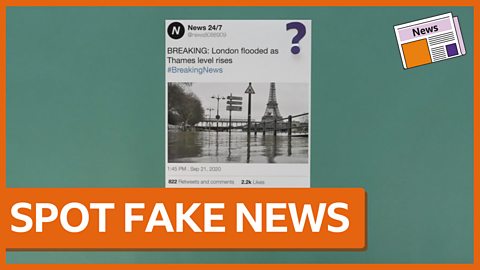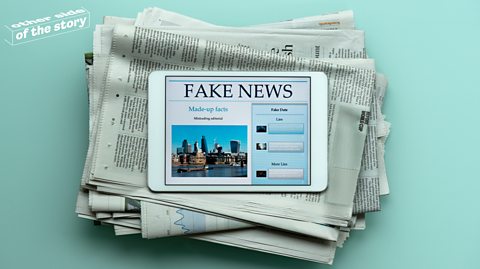
Welcome to the BBC Other Side of the Story workshops
In the first workshop, we'll be looking at how different types of news can give completely different sides to a story.
Please complete the online activities below before the workshop. The tasks can be done on your own or together with a teacher in the classroom. They help to explain some of the news topics that you will learn more about in the workshops.
(15-20 minutes)
If you don't have much time, please finish tasks 1 to 3.
Take on the quizzes and watch the videos

1. Quiz: How much do you know about fake news?
(3 minutes)
Take this simple quiz to find out how much you know about fake news.
2. Watch: Why is fake news dangerous?
(5 minutes)
In this video, BBC Radio 1 presenter Vick Hope finds out about the different types of fake news. Watch carefully as there's a quiz to follow!
Student: I get most of my news on social media.
Student: Instagram
Student: Just watch it on TV.
Student: Facebook.
Student: Snapchat. Even Tiktok if you get someone rambling on about something for a minute.
Vick Hope: News. It is everywhere.
Student: Celebrity news. Political news.
Student: Sport news.
Student: Boring news.
Student: But then it’s also just anything that happens.
Student: Falling over in a funny way.
Student: A lot of fake news.
Student: Fake news, there’s a lot of that.
Student: You can’t avoid it.
Vick Hope: It’s switched on twenty four hours a day and with the mega fast rise of social media, it is constantly pumped into your feeds.
Donald Trump: It’s fake news. It’s fake. I’m telling ya, it’s just fake news.
Vick Hope: We’ve all heard the phrase “fake news”, but what does it actually mean and does it matter? Latest research shows that only two percent of young people can spot it and over 60 percent say that fake news stories make them trust all news less. If we don’t trust the news, how will we know what’s really going on?
Student: I’d say that fake news has definitely left me confused.
Student: It’s kind of like Chinese whispers, you know what I mean?
Student: Anyone can make anything and they can be totally anonymous for what they’ve created and what they’ve put out into the world.
Student: You can’t even have a proper opinion on something because you don’t know what’s real or fake.
Student: It can ruin people’s lives.
Student: It does confuse me quite a lot. When you share it then you’re spreading that as well.
Vick Hope: It doesn’t have to be like that. With a little bit of knowledge, you can be the generation that got smart about fake news. We’ll show you the different types and who’s behind it. Most of the fakes created are deliberate, now this is known as disinformation, some though are mistakes and this is called misinformation.
James Ball: Journalists get a load of training in how to find out what’s true and they have lots of checks and editors to try and make sure when they tell you something they’ve got good reason to believe it. And crucially, if a journalist does make a mistake, they say sorry and they fix it because they have to.
Vick Hope: Light hearted stories that make humour from real news and situations can sometimes be mistakenly shared as real.
Alastair Reed: Satirical website The Onion wrote an article about Kim Jong-un, the North Korean dictator, which said that he was the sexiest man in the world – and this is a joke website in the US. People in China and in North Korea didn’t realise that is was a joke and shared it, believing it was true.
Vick Hope: One of the most wide spread types of fake news is clickbait.
James Ball: We’ve all seen that sort of headline that looks great, “Hey you’re the millionth person to this site, claim your free iPad”. It’s never true and that’s a kind of fake information that can leave you really disappointed.
James Ball: There’s a trick on the internet where you’ll also see a really intriguing news story. “The Pope endorses Donald Trump”. And it’s something that makes you go, whoa, what’s that about and click. They’re giving you a story that looks sensational so that millions of people click it. And then they run loads of adverts next to them and so for each click they might get half a penny or even less than that but if you can get tens of thousands of people to click your really exciting looking headlines then you’re going to make a lot of money from them.
Vick Hope: But not all clickbait is fake news and money isn’t the only motivation for people who create it. The oldest type of fake news is propaganda. Now it’s been around for years but because of the internet, so many more of us see it these days.
Alastair Reed: Previously politicians and powerful people used propaganda to push their ideas and their politics onto the wider population and that might be through leaflets or a TV broadcast. The thing is what social media has done is to allow anybody to use those same tools and those same tactics to push their ideas onto others. It can affect the future of a whole country, if lots of people are making decisions and voting based off things that aren’t true.
Vick Hope: We all need to think about fake news and its consequences. How would you feel if someone made up a rumour about you? Think how bad you’d feel if someone important lied to you and you only found out later that it wasn’t true. Why not pause before you share and think if what you’re sharing is fact or fake.
3. Quiz: What did you learn from the video?
(2 minutes)
4. Watch: How does fake news hijack your brain?
(2 minutes)
More than 60% of young people say they regret sharing fake news, according to a BBC Bitesize survey for Other Side Of The Story.
But what techniques does fake news use and why do we find it so hard to spot? Tik Toker Alex J Heath gives us a 60 second rundown on how fake news works.
5. Are these images real or fake?
(3 minutes)
See how good your fake-spotting skills are by taking on our monthly AI or real quiz.
Fake news can come in lots of forms, including images and videos, and the rise of artificial intelligence (AI) has made it easy for people to generate images that are completely fake but look very real.
Often these are used in a funny or creative way, but they can also spread fake news by tricking people into believing something that didn't really happen.
Congratulations, you've completed all the pre-workshop tasks!
Well done for improving your fake news knowledge. If you have time, watch the videos below to help get you ready for the next workshop.
Five ways to spot misleading images online
Use these simple tips to spot suspicious images.


